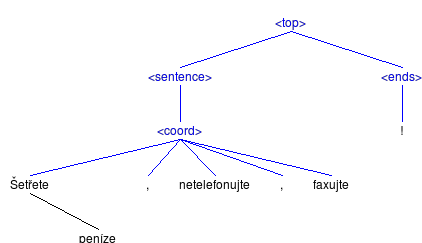| Version 14 (modified by , 15 years ago) (diff) |
|---|
Documentation
Introduction
SET is an open source tool for syntax analysis of natural languages. It is based on the principle of detection of important patterns in the text and incremental segmentation of the sentence. Its core consists of a set of patterns (or rules) and a parsing engine that analyses the input sentence according to given rules. Currently, SET is distributed with a set of rules for parsing the Czech language, containing about 220 rules. A tree viewer for displaying parser output is also present.
System features
The system is able to parse a morphologically annotated sentence in the vertical (or BRIEF) format, i.e. one token per line, in word - lemma - tag order. Ambiguous comma-delimited lemmas and tags are allowed in the input. The tags can be either in the attribute format, as used by the ajka morphological analyser, or in the positional format, as described here (in this case, the --postags switch needs to be used). Examples of correct input files: example 1, example 2, example 3, example 4 (in Czech).
As the output, the system returns syntactic information found in the input sentence in several possible formats:
- All patterns found in the input sentence This information is printed on stderr in the form of matched tokens followed by the particular rule. It is indicated by label Match found.
- Best matches The best pattern matches that are selected by the parser ranking functions and that are used for building the output tree. This information is printed on stderr in the form of matched tokens followed by the particular rule as well. It is indicated by label Match selected.
- Hybrid trees Full syntactic trees containing phrasal and dependency elements together. The native output of the parser. In the text form, it is printed on stdout; it can be also displayed in the graphic module.
- Dependency trees Full syntactic trees containing only dependency elements, corresponding to the formalism used by the Institute of Formal and Applied Linguistics in Prague. In the text form, it is printed on stdout; it can be also displayed in the graphic module.
- Phrasal trees Full syntactic trees in the constituent format. In the text form, it is printed on stdout in two possible codings; it can be also displayed in the graphic module.
- Collocations Pairs of words in dependency relations. Pairs of lemmas and tags are also output.
- Phrases Word chunks that form phrases in the sentence. These can be output in two possible formats.
The output trees in the text form are encoded by set of lines, each of them representing one node of the resulting tree. Each line contains four TAB-delimited fields:
- Node ID (integer number)
- Node label
- Node dependency ID (integer number)
- Dependency type ('p' or 'd', for phrasal or dependency edge)
Phrasal trees can also be printed in the "LAA" format (using the --laa switch) that enables the trees to be compared using the Leaf Ancestor Assessment metric, as described here.
Program usage
The usage of the system is very simple:
./set.py [-gd] <file>
where
-gspecifies graphical tree output (if not given, output tree will display only in the text format that is not readable well),-dswitches to the dependency tree output, instead of hybrid trees, and<file>should contain a tagged Czech sentence in the BRIEF format as showed above and in UTF-8 encoding.
The system performs parsing of the input sentence according to rules defined in the file grammar.set that is present in the installation. The structure of the rules and the process of analysis are further described in the following sections.
Rules structure
Rules syntax
A general format of syntax rule is as follows:
TMPL: <template> <action list>
The template cannot be wrapped into several lines, whereas the action list can be wrapped before the action name (so that newline always starts with an action name).
A template is a sequence of following types of tags describing a matching text segment:
An action lists is a sequence of an arbitrary number of actions.
SET rules
For current rules used in the SET system, please refer to the grammar.set definition file in the source package.
Implementation overview
The SET system consists of several Python modules:
grammar-- loading, organizing and parsing of rules sets, definition of theRuleaGrammarclass.
token-- definition of theTokenclass (and its derivatives) representing a single word/token.
segment-- input parsing, definition of theSegmentclass representing the input sentence (a list ofTokenobjects).
matcher-- definition of theMatchandMatcherclass. AMatchobjects represents a rule realization, whereasMatchersearches for possible matches on a given segment.
parser-- implements the parsing procedure itself (Parserclass) including ranking functions.
tree_view-- implements displaying graphical output of trees.
utils-- contains several helper functions.
set-- represents the main module.
Screenshots
Comparison of hybrid (left) and dependency (right) output trees for the input sentence: Šetřete peníze, netelefonujte, faxujte! (Save money, use fax instead of calling!)
Attachments (9)
-
dp.pdf (395.8 KB) - added by 16 years ago.
Diploma thesis about SET (in Czech)
-
s1.txt (221 bytes) - added by 16 years ago.
Sample sentence 1 (in Czech)
-
kovar_syntakticka_analyza.pdf (113.7 KB) - added by 16 years ago.
Faculty project proposal (in Czech)
- s2.txt (152 bytes) - added by 15 years ago.
- s3.txt (807 bytes) - added by 15 years ago.
- s4.txt (220 bytes) - added by 15 years ago.
- tree1.png (6.9 KB) - added by 15 years ago.
- tree2.png (5.1 KB) - added by 15 years ago.
- tree3.png (3.3 KB) - added by 15 years ago.
Download all attachments as: .zip


